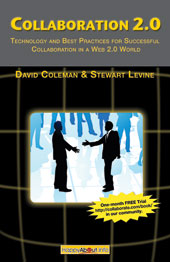
In their book Collaboration 2.0, Stewart Levine and David Coleman say something to the effect of there being 3 parts to the collaboration spectrum on this "inter-web" business. They are as follows:
- Technology
- People
- Process
I maintain that it's the same in any given meeting or group driven project. Sometimes the technology is very simple (pens and paper vs. "inter-web"), but the right tool for the right job is an important part of collaboration. My mindshare is often dominated by the technology and process side of things. I think both can be applied to have beneficial effects on the psychology of a group, and clearly all overlap, but the "People" part is the area I need to be conscious of paying closer attention to.
So, as with most things, I'd like to take an experimental approach to improving how I interact with others. When I think of people, I think of the most important one first... me. How am I going to prepare myself or create the necessary conditions that will allow me to be most effective in a group setting?It's kind of cause-and-effect, and a bit like putting out fires; but psychologists have a tool that I'd like to introduce in a work setting that could help to mitigate damaging behaviour by creating self awareness. Self awareness around "triggers" specifically. A trigger could be anything that sets in motion a pattern reaction. We see people reacting to their triggers constantly. A trigger for me might be to get angry or make fun of someone I perceive to be behaving unreasonably. To find out why people respond to triggers as they do is important to form an awareness around, but you'll have to turn to a more specialized source for that.
For my purposes, I want to know what my pattern unproductive behaviours are, and how they express in a group setting. So a team of colleagues and I are going to try and park our egos, make ourselves temporarily vulnerable (ugh), and flesh out a list of our independent triggers. This is quite the experiment. I will have to approach the engagement with humility, and share my known flaws. I'll also have to be prepared to listen to what my colleagues consider as my negative behaviour (I always thought my shouting profanities was endearing!). I will of course be offering them observations as well.The outcome will be a list of our triggers and pattern behaviours, along with notes on how we should alternatively behave (which may even be disengaging) to avoid causing damage. Lastly, we will also list how we would prefer to be notified and receive feedback for each instance in real-time. Our team will be accountable for making progress in these areas and helping each other make progress. I'm excited to see if the acknowledgement and awareness will have an impact.
Of course, the proper environment for this meeting is critical. "Trust" is a word that I don't use often, and is about as soft as it gets in my eyes. But without trust, this excercise would be redundant. A closely knit team has all made one another confident in our intentions and desire to improve our interactions, so I'm comforted that proceedings will be civil. But as mentioned, this People component of the collaboration spectrum is a tricky one.I look forward to reporting back on this experiment's progress.

No comments:
Post a Comment